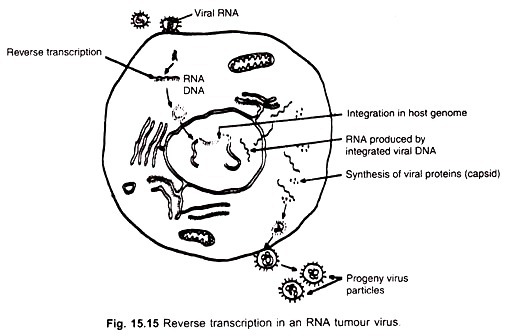In this article we will discuss about the meaning of reverse transcriptases.
There are some cancer causing RNA viruses such as the Rous sarcoma virus (RSV) which produces cancer in chickens, avian myeloblastosis virus (AMV) causing leukemia in birds, and the mammary cancer and leukemia viruses in rodents. The viruses can cause heritable transformation of normal cells of animals and man into malignant cells in vitro.
In the early 1960s H.M. Temin had suggested that RNA of cancer viruses must be transcribing a DNA intermediate in order to become integrated into the host cell genome. But this view was not accepted as it contradicted the central dogma, according to which information flows only from DNA to RNA to protein.
This idea was substantiated later when Temin and D. Baltimore independently discovered RNA-directed DNA polymerases in RNA tumour viruses. The enzymes were also called reverse transcriptases. In 1975 Temin and Baltimore were awarded the Nobel Prize.
The purified reverse transcriptases from different RNA viruses have molecular weights ranging between 70,000 and 160,000. Like RNA polymerases and the DNA directed DNA polymerases, the reverse transcriptases also synthesise DNA chains in the 5′ to 3′ direction using deoxyribonucleoside triphosphate as precursors on an RNA template.
They cannot initiate new DNA chains but can only add deoxynucleotides to a short RNA primer strand with a free 3′-OH end. The primer strand appears to be some tRNA molecule. Reverse transcription produces in the host cell cytoplasm RNA-DNA hybrid molecules in which the single DNA strands are complementary to the RNA template of the viral genome.
The reverse transcriptase catalyses the breakdown of the RNA releasing the single stranded DNA. The DNA strands become converted into double helical and circular configurations forming the proviruses which become integrated into the host genome by recombination (Fig. 15.15). After integration the pro-viral DNA is transcribed by RNA polymerase II of the host cell.
It seems that reverse transcription occurs in eukaryotes both in normal cells and in cells infected with RNA tumour viruses. Reverse transcriptases have been isolated from malignant cells of some animals and from human patients of leukemia. Such transcriptases can utilise either RNA or DNA as template although RNA is preferred.
